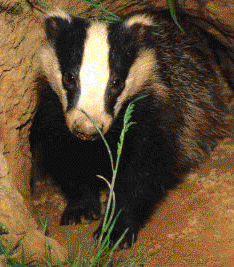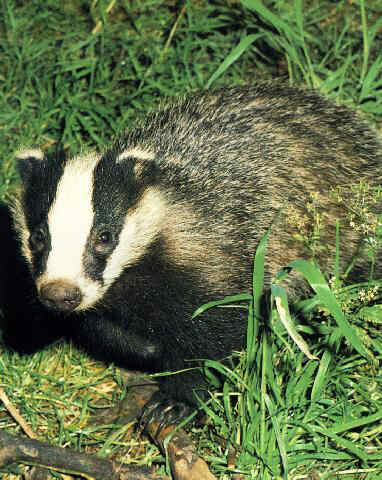THE BADGER Meles meles


Black and white striped face. Body grey, black fur on legs.
Head/body length: about 750mm, tail 150mm
Weight: average 8-9kg in spring, 11-12kg in autumn.
Badgers are nocturnal and rarely seen during the day. When not active, badgers usually lie up in an extensive system of underground tunnels and nesting chambers, known as a sett. Occasionally, when the weather is particularly hot
Badgers live in social groups of four to 12 adults. Only one female badger in a social group normally breeds, although occasionally two or more may do so. Litters of two or three cubs are usually born in February.
Badgers are widespread in Britain but are most common in the south west, rare in East Anglia and only thinly distributed in Scotland.
In 1998 there were estimated to be around 42,000 social groups of badgers, and just under 200,000 adult badgers. By 1997 this had risen to just over 50,000 social groups and 310,000 adult badgers. The population is now probably stable. Mortality is high, with around one-fifth of adults dying each year. Road traffic accidents are a major cause of death. The maximum life expectancy of a badger is about 14 years, though very few survive so long.
Badgers are protected by a number of laws. Badgers may not be deliberately killed, persecuted or trapped. Where badgers pose a problem, licences can be issued to permit certain activities. Badger baiting (using dogs to fight badgers) has been outlawed since 1835. The Badgers Act 1973 afforded limited protection against badger digging, but this practice was not finally outlawed until 1981.
The Protection of Badgers Act 1992 consolidates past badger legislation and, in addition to protecting the badger itself, makes it an offence to damage, destroy or obstruct badger setts.
About 80 local groups have been formed by enthusiasts wishing to protect and study badgers. There are many positive ways to help badger conservation. These include protecting badgers from diggers and baiters by re-inforcing setts, helping with care and rehabilitation of injured badgers, having tunnels and badger proof fencing added to new road schemes and giving advice about setts in the way of developers.
Some badgers are infected with bovine tuberculosis, particularly in the south west of England. These animals are the subject of a control campaign by the Ministry of Agriculture, Fisheries and Food. There is a continuing debate about the role of badgers infecting cattle with TB.
Where can I go to see badgers?
Many local badger groups organise badger watches. Join these, your Wildlife Trust or The Mammal Society to make contact with other badger watchers in your area. The National Federation of Badger Groups can tell you the address of your local badger group (NFBG, 15 Cloisters Business Centre, 8 Battersea Park Road, London SW8 4BG).
How do I know if badgers are in my area?
Walk along field edges looking for badger trails under fences or through hedges, or search in woods and other likely sites of setts. Further advice on field signs is given in the books listed below.

 Return to the Fridge door
Return to the Fridge door